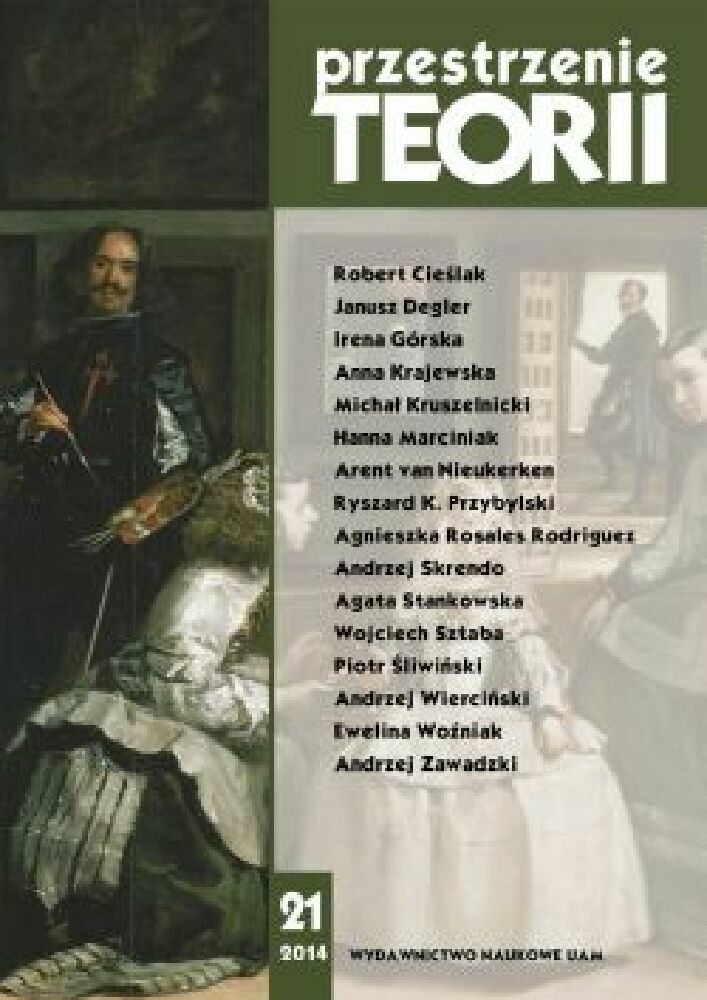Abstrakt
This article explores the issue of postmemory and secondary witnessing as dealt with in Tadeusz Różewicz’s 2002 poem The Professor’s Little Knife. The paper presents two photographs which refer to the problem of the Holocaust’s representation and its limits. The first picture comes from the collection of the U.S. Holocaust Memorial Museum; however, the author concealed its origins and changed its appearance so that it resembled a retro nude photograph. The second one is a raw, non-stylized picture of a knife that belonged to Professor Porębski during imprisonment in Auschwitz-Birkenau concentration camp. By using various interpretation methods, such as the deconstruction of an image or empathic reading, the author of this article examines the limits and consequences of treating a photograph as “spectral evidence”.Bibliografia
E. van Alphen, Affective Operations on Art and Literature, „Res: Anthropology and Aesthetics” 2008, nr 53/54.
E. van Alphen, Afekt, trauma i rozumienie: sztuka ponad granicami wyobraźni. Ernst van Alphen w rozmowie z Romą Sendyką i Katarzyną Bojarską, „Teksty Drugie” 2012, nr 4.
J. Bennett, Empathic Vision. Affect, Trauma, and Contemporary Art, Standford 2005.
A. Ubertowska, Przepisywanie Zagłady. Shoah w późnych poematach Tadeusza Różewicza, „Pamiętnik Literacki” 2004, z. 2.
T. Różewicz, nożyk profesora, Wrocław 2002.
E. van Alphen, Caught by History: Holocaust Effects in Contemporary Art, Literature and Theory, Stanford 1997.
B. Shalcross, Rzeczy i Zagłada, Kraków 2010.
T. Różewicz, Wycieczka do muzeum, [w:] tenże, Utwory zebrane. Proza 1, Wrocław 2003.
G. Didi-Huberman, Obrazy mimo wszystko, przeł. M. Kubiak Ho Chi, Kraków 2008, s. 128.
M. Olin, Roland Barthes’s „Mistaken” Identification, [w:] taż, Touching Photographs,Chicago–London 2012, s. 69.
Jak wyśpiewać sekcję zwłok? W rozmowie udział biorą: L. Burska, A. Chłopecki, M. Dziewulska, P. Gruszczyński, M. Poprzęcka i M. Zaleski, „Res Publica Nowa” 2001, nr 7.
E. van Alphen, Deadly Historians: Boltanski’s Intervention in Holocaust Historiography, [w:] Visual Culture and the Holocaust, red. B. Zelizer, London 2001.
H.White, Realizm figuralny w literaturze świadectwa, przeł. E. Domańska, [w:] tenże, Proza historyczna, red. E. Domańska, Kraków 2009.
G. Didi-Huberman, Devant le temps. Histoire de l’art et anachronisme des images, Paris 2000.
Licencja
Autorzy
Autorzy tekstów przyjętych do publikacji w czasopiśmie „Przestrzeniach Teorii” są zobowiązani do wypełnienia, podpisania i odesłania na adres redakcji umowy o udzielenie nieodpłatnej licencji do utworów, z zobowiązaniem do udzielania sublicencji CC.
Zgodnie z umową, autorzy tekstów opublikowanych w czasopiśmie „Przestrzeniach Teorii” udzielają Uniwersytetowi im. Adama Mickiewicza w Poznaniu niewyłącznej i nieodpłatnej licencji oraz zezwalą na użycie sublicencji Creative Commons Attribution-NonCommercial-NoDerivatives 4.0 International (CC BY-NC-ND 4.0).
Autorzy zachowują prawa do dalszego, swobodnego rozporządzania utworem.
Autorzy, którzy wykorzystują w swoim tekście cudze utwory (np. ilustracje, fotografie) proszeni są o dostarczenie do redakcji czasopisma zgodę na publikację od uprawnionych podmiotów.
Użytkownicy
Zainteresowani użytkownicy internetu uprawnieni są do korzystania z utworów opublikowanych po 2015 roku „Przestrzeniach Teorii” tylko w calach niekomercyjnych, pod następującymi warunkami:
- uznanie autorstwa - obowiązek podania wraz z rozpowszechnionym utworem, informacji, o autorstwie, tytule, źródle (odnośniki do oryginalnego utworu, DOI) oraz samej licencji;
- bez tworzenia utworów zależnych - utwór musi być zachowany w oryginalnej postaci, nie można bez zgody twórcy rozpowszechniać np. tłumaczeń, opracowań.
Do wszystkich tekstów opublikowanych przed 2015 r. prawa autorskie są zastrzeżone.
Inne
Uniwersytet im. Adama Mickiewicza w Poznaniu zachowuje prawo do czasopisma jako całości (układ, forma graficzna, tytuł, projekt okładki, logo itp.).
